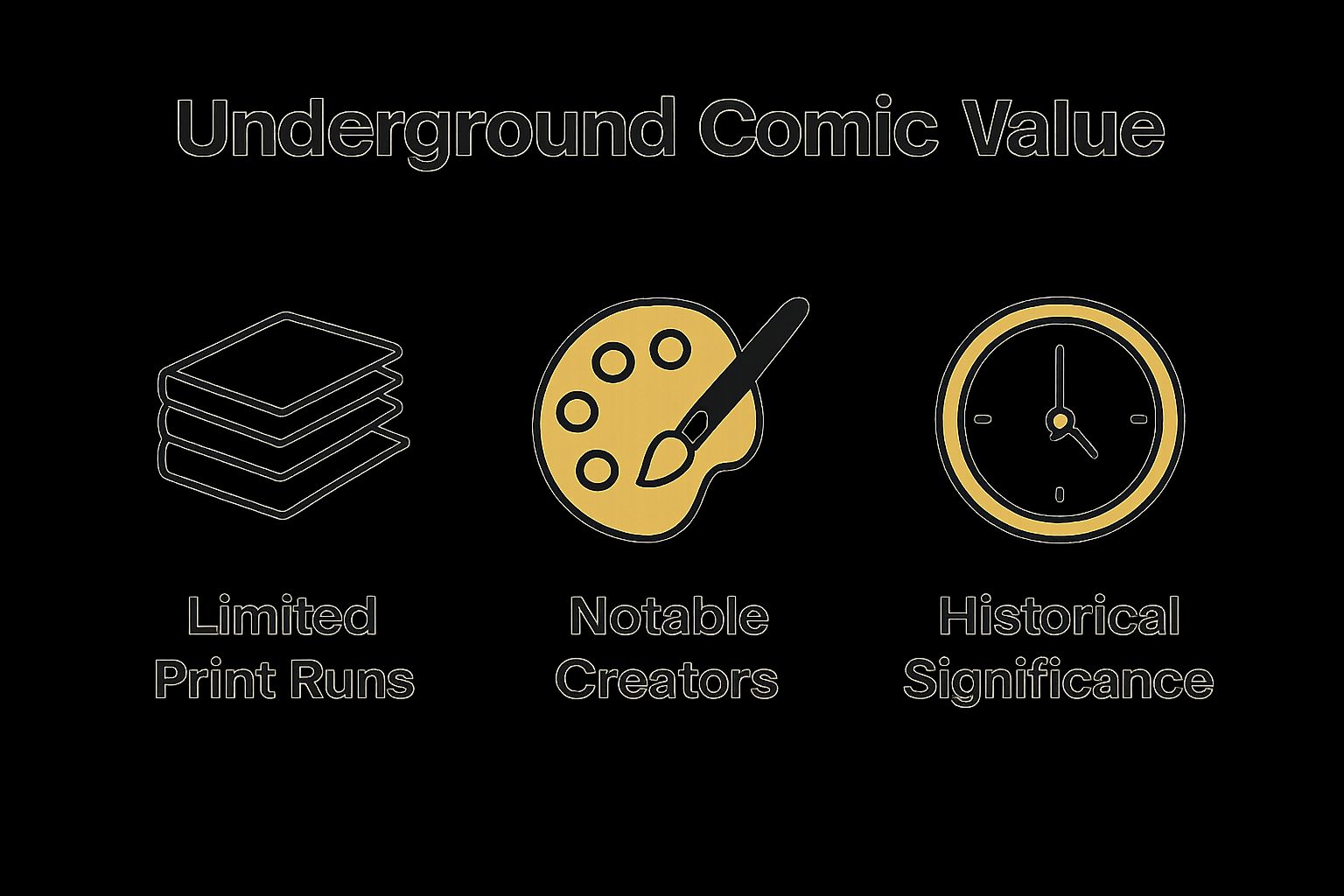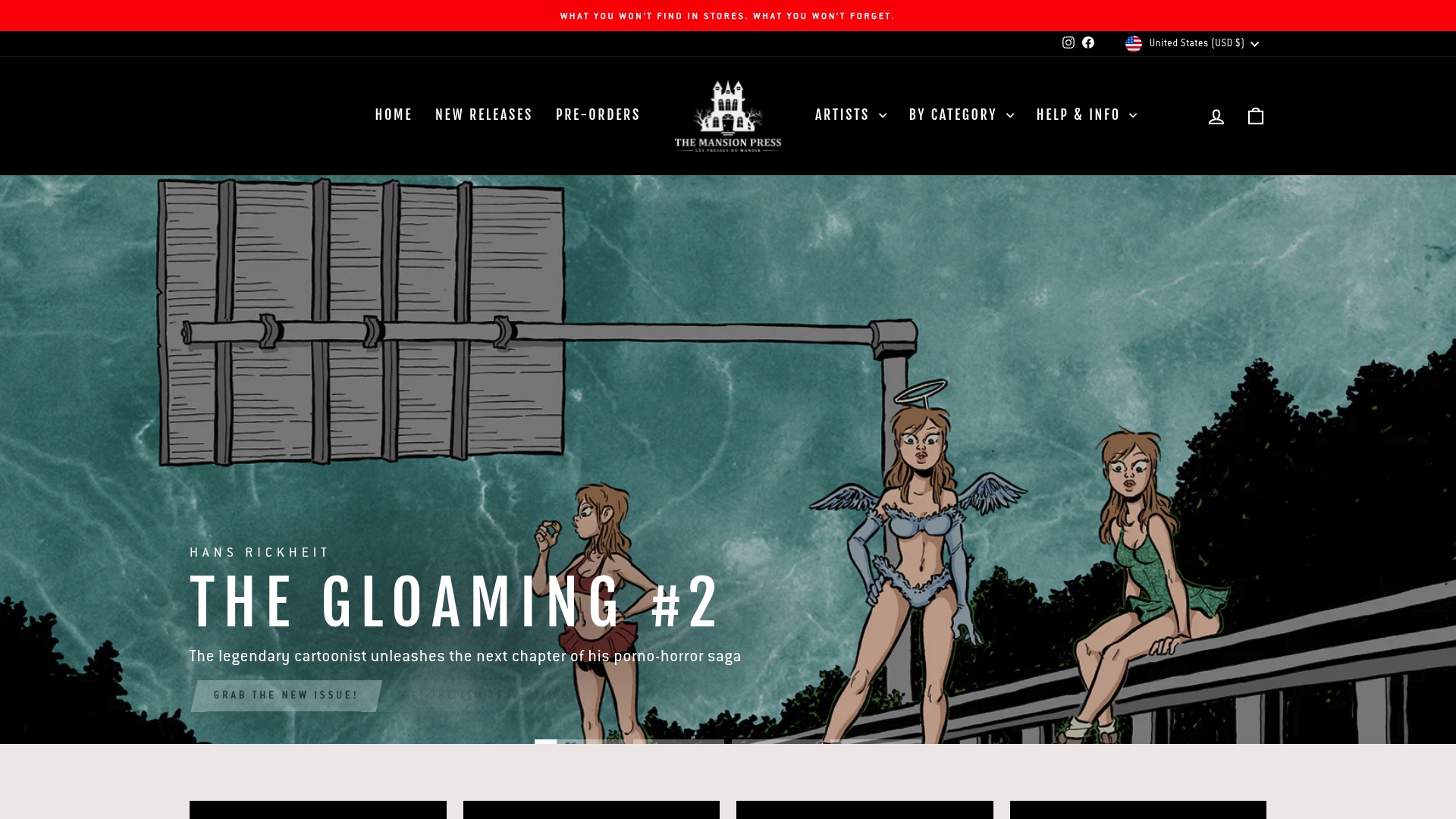Understanding Why Collect Underground Comics Matters
Underground comics flipped the art world on its head, breaking free from mainstream rules and opening doors to powerful scenes of rebellion and self-expression. Most people think comics are just fun stories for kids, but these independent zines tackled topics so bold that mainstream publishers would not dare touch them. One wild fact is that some early underground comics had print runs as tiny as 1,000 copies and yet changed how we talk about politics, race, and identity with nothing but ink and raw honesty.
Table of Contents
- Defining Underground Comics: A Unique Art Form
- The Cultural Significance of Underground Comics
- Understanding the Value in Collecting Underground Comics
- Exploring the Community Behind Underground Comics
- The Evolution of Underground Comics Through Time
Quick Summary
| Takeaway | Explanation |
|---|---|
| Underground comics push creative boundaries | They enable artists to explore themes often deemed taboo, providing unique narratives not found in mainstream media. |
| Artistic autonomy defines underground comics | Artists enjoy total creative freedom, rejecting commercial constraints, allowing unfiltered expression of social and political themes. |
| Collecting underground comics preserves culture | Collectors play a vital role in maintaining these important historical documents, ensuring marginalized perspectives are remembered. |
| Network support fuels underground movements | Communities of artists collaborate to share resources and ideas, fostering creative resilience and challenging societal norms. |
| Evolution reflects broader social change | Underground comics transitioned from counterculture expressions to respected art forms, showcasing their growing influence on society. |
Defining Underground Comics: A Unique Art Form
Underground comics represent a revolutionary artistic movement that emerged from the counterculture era, challenging traditional comic book narratives and visual representations. These independent publications reject mainstream commercial constraints, offering artists unprecedented creative freedom and social commentary.
Origins and Artistic Philosophy
Underground comics, often referred to as “comix,” originated in the late 1960s as a radical form of artistic expression. According to Encyclopedia Britannica, these comics emerged from a desire to explore subjects completely forbidden in traditional publishing, including explicit sexuality, political critique, and personal narratives that mainstream media would not touch.
Key characteristics of underground comics include:
- Complete creative autonomy for artists
- Rejection of commercial publishing standards
- Exploration of taboo social and political themes
- Graphic and often provocative visual storytelling
Cultural Significance and Artistic Impact
Underground comics functioned as more than mere graphic art they were powerful vehicles for social critique and personal expression. Artists like Robert Crumb, Gilbert Shelton, and Art Spiegelman used this medium to challenge societal norms, document counterculture experiences, and provide unfiltered perspectives on complex social issues.
These comics represented a stark departure from traditional comic book formats. They were typically self published, often produced using rudimentary printing techniques like photocopying, which emphasized their grassroots and independent nature. Learn more about underground comic creators to understand the depth of this artistic movement.
The underground comics movement transformed graphic storytelling by proving that comics could be a serious art form capable of profound social commentary, personal reflection, and challenging established narratives. By prioritizing artistic integrity over commercial appeal, these creators established a new paradigm for visual storytelling that continues to influence contemporary graphic arts and independent publishing.
The Cultural Significance of Underground Comics
Underground comics emerged as a powerful sociocultural phenomenon that transcended traditional artistic boundaries, serving as a critical platform for marginalized voices and radical social commentary during transformative periods of American history.
Challenging Social Norms and Censorship
Cultural historians recognize underground comics as revolutionary tools of expression that directly confronted societal taboos. These publications became platforms for challenging established narratives around sexuality, race, politics, and personal identity. Artists used graphic storytelling to critique systems of power, expose social inequities, and provide unfiltered perspectives typically suppressed by mainstream media.
Key ways underground comics challenged social structures included:
- Presenting explicit sexual narratives
- Critiquing government policies and institutional racism
- Exploring marginalized community experiences
- Dismantling traditional gender representations
Artistic Freedom and Social Protest
Underground comics represented more than artistic rebellion they were vehicles of social transformation. Comic artists like Robert Crumb, Trina Robbins, and Spain Rodriguez used their work to document counterculture movements, challenge conservative social norms, and amplify voices systematically excluded from traditional publishing platforms.
Explore visual storytelling techniques that made these comics so powerful in communicating complex social narratives. These artists transformed graphic storytelling from commercial entertainment into a sophisticated medium of critical social discourse.
By rejecting commercial constraints and embracing radical authenticity, underground comics became crucial historical documents. They captured the emotional landscape of social movements, preserved marginalized experiences, and provided honest reflections of cultural tensions during pivotal moments of social change. Their legacy continues to inspire contemporary graphic artists and social commentators who understand the profound power of visual storytelling as a mechanism for social critique and personal expression.
Understanding the Value in Collecting Underground Comics
Collecting underground comics represents more than a mere hobby it is an intricate form of cultural preservation, artistic appreciation, and historical documentation that transcends traditional collecting methodologies.
Historical and Artistic Investment
Art market experts recognize underground comics as significant cultural artifacts with substantial potential for monetary and historical appreciation. These publications are not simply graphic narratives but complex cultural documents that capture moments of social transformation, making them valuable both as artistic expressions and historical records.
Key factors contributing to the value of underground comics include:

- Limited original print runs
- Historical significance of specific issues
- Artistic reputation of creators
- Condition and preservation of the comic
- Cultural context and social commentary
Preservation of Cultural Narratives
Underground comics serve as critical repositories of marginalized experiences and countercultural perspectives. Collectors play a crucial role in maintaining these fragile historical documents, ensuring that alternative narratives and underground artistic movements are not lost to mainstream historical accounts.
Check out our guide on collecting rare comics to understand the nuanced strategies for building a meaningful collection. Each preserved comic becomes a window into complex social landscapes that traditional historical records often overlook.
Beyond monetary value, collecting underground comics represents an act of cultural stewardship. Collectors become custodians of artistic expressions that challenge societal norms, document critical social movements, and preserve voices that might otherwise be silenced. By carefully maintaining these publications, collectors ensure that future generations can understand the rich, complex tapestry of social and artistic resistance that underground comics represent.

Exploring the Community Behind Underground Comics
Underground comics emerged not just as an artistic movement but as a vibrant, interconnected social ecosystem that fostered radical creativity, mutual support, and collective resistance against mainstream cultural norms.
Networks of Artistic Collaboration
Academic research reveals that underground comics communities operated as decentralized networks of artists, publishers, and enthusiasts who shared resources, ideas, and a commitment to challenging societal boundaries. These networks transcended traditional publishing models, creating alternative distribution channels that prioritized artistic integrity over commercial success.
Key characteristics of underground comics communities included:
- Informal publishing collectives
- Self funded printing and distribution
- Mutual support among creators
- Shared countercultural values
- Independent zine and comic festivals
Grassroots Distribution and Communication
Before digital platforms, underground comics creators developed sophisticated grassroots distribution systems. Comic conventions, independent bookstores, head shops, and direct mail became critical mechanisms for sharing work and building community. Learn more about comics zine culture to understand these intricate communication networks that allowed marginalized voices to connect and amplify their narratives.
These communities were more than artistic circles they were social movements that challenged institutional power through collective creativity. Artists supported each other financially, shared printing resources, and created spaces where unconventional narratives could flourish. By rejecting mainstream publishing structures, they built resilient networks that preserved alternative perspectives and fostered a spirit of radical artistic freedom.
The Evolution of Underground Comics Through Time
Underground comics represent a dynamic artistic movement that transformed dramatically from radical counterculture expression to a respected form of graphic storytelling, reflecting broader social changes and artistic innovations across decades.
Roots in Counterculture Rebellion
Cultural historians trace underground comics to the late 1960s, when artists like Robert Crumb, Gilbert Shelton, and Art Spiegelman emerged as visual provocateurs. These early creators used graphic narratives as weapons of social critique, challenging conservative social norms, documenting countercultural experiences, and providing platforms for marginalized voices.
Key transformative periods in underground comics development included:
- Late 1960s radical artistic emergence
- 1970s expansion of alternative publishing networks
- 1980s integration into broader independent art scenes
- 1990s mainstream artistic recognition
- 2000s digital transformation of comic distribution
Transition to Mainstream Artistic Recognition
As societal attitudes shifted, underground comics gradually transitioned from subversive marginalia to respected artistic medium. Artists who once operated in underground publishing collectives began receiving critical acclaim, with many eventually influencing mainstream graphic novel and comic book industries.
Discover strange comics that challenge artistic boundaries to understand how these radical narratives continue to push creative limits. The evolution of underground comics demonstrates how artistic movements can transform from revolutionary expressions to foundational cultural documents, preserving complex social histories through visual storytelling.
Preserve Underground Comic History With Rare Collector’s Editions
If you care about the stories told in underground comics, you know their value goes far beyond paper and ink. As this article explains, every underground comic is a powerful record of artistic rebellion, creative freedom, and marginalized voices. Missing out on rare editions means losing a piece of cultural history, and it can be difficult to find authentic, well-preserved works in one trusted place.

At The Mansion Press, we help you bridge this gap. Our curated selection of artbooks, comics, and limited collector’s editions is designed for people who want more than just entertainment. Each item connects you to the countercultural legacy described in this article. Take the next step to grow your collection with pieces that matter. Visit our site now to claim exclusive works before they disappear.
Frequently Asked Questions
What are underground comics?
Underground comics, often known as ‘comix,’ are independent publications that emerged in the late 1960s. They offer artists the creative freedom to explore taboo subject matter and challenge traditional narratives.
Why is collecting underground comics important?
Collecting underground comics is significant because it preserves cultural narratives and artistic expressions that challenge societal norms. These comics serve as historical documents that capture moments of social transformation.
How do underground comics differ from mainstream comics?
Underground comics differ from mainstream comics in their rejection of commercial constraints, allowing for more explicit themes, personal narratives, and artistic experimentation that is often absent from traditional publishing.
The table below highlights key differences between underground comics and mainstream comics, summarizing how each approaches creative freedom, content, and distribution.
| Aspect | Underground Comics | Mainstream Comics |
|---|---|---|
| Creative Control | Complete autonomy for artists | Heavily influenced by publishers |
| Themes | Taboo, political, personal, experimental | Broad appeal, less controversial |
| Distribution | Self-published, grassroots channels | Retailers, mass market |
| Artistic Style | Provocative, raw, independent | Polished, editorial standards |
| Purpose | Social critique, self-expression | Entertainment, commercial success |
What factors determine the value of underground comics?
The value of underground comics is influenced by factors such as the rarity of the print run, the historical significance of specific issues, the artistic reputation of the creators, the condition of the comic, and the cultural context of the work.
Below is a table outlining factors that influence the value of underground comics, organizing the main points discussed in the article for collectors to consider.
| Factor | Description |
|---|---|
| Print Run Size | Many had limited runs, sometimes as small as 1,000 copies, increasing rarity |
| Historical Significance | Issues tied to key social movements or periods are more valuable |
| Creator Reputation | Artists with significant impact or recognition fetch higher prices |
| Condition | Well-preserved comics are much more valuable |
| Cultural Context | Content reflecting major cultural shifts or protests enhances value |

